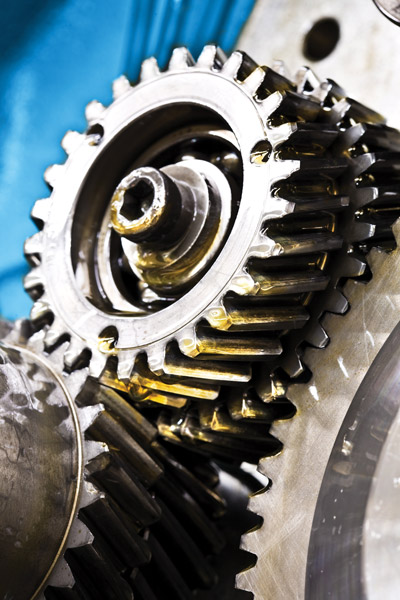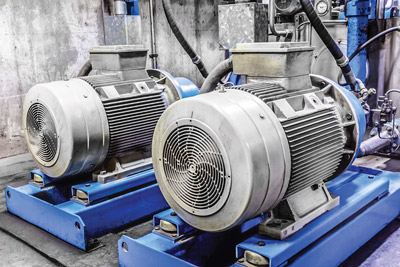How Lubrication Excellence Aligns with ISO 55000
 In previous issues of Machinery Lubrication, the asset management standard published by the International Organization for Standardization (ISO) known as ISO 55000 was discussed in regards to how it can provide a framework for supporting the deployment of lubrication excellence. This article will go further by explaining how the requirements for ISO 55000 can be aligned with the features of lubrication excellence to provide a deeper understanding of how a world-class lubrication program can be developed to fulfill these standard requirements, leading to greater machine reliability and eventual ISO certification.
In previous issues of Machinery Lubrication, the asset management standard published by the International Organization for Standardization (ISO) known as ISO 55000 was discussed in regards to how it can provide a framework for supporting the deployment of lubrication excellence. This article will go further by explaining how the requirements for ISO 55000 can be aligned with the features of lubrication excellence to provide a deeper understanding of how a world-class lubrication program can be developed to fulfill these standard requirements, leading to greater machine reliability and eventual ISO certification.
ISO 55000 was released in 2014 with the goal of improving the value realized from an organization’s assets. The standard consists of a series of three documents: ISO 55000, ISO 55001 and ISO 55002. The series defines the requirements and guidelines for the effective design, implementation and maintenance of an asset management system. Implementing ISO 55000 can give an organization the confidence that the right things are being done in its asset administration to support the organization’s mission and objectives, such as the production of goods and services.
Defining an Asset and Asset Management
According to ISO 55000, “An asset is an item, thing or entity that has potential or actual value to an organization. The period from the creation of an asset to the end of its life is the asset life.”
Asset management can be defined as the “coordinated activity of an organization to realize value from assets.” It involves the balancing of actions, costs, opportunities and risks related to the desired performance of assets to achieve organizational objectives. In other words, asset management relates to all actions involved in a plant to have productive machines, technologies and systems.
Lubrication Excellence as Part of Asset Management
A good asset management system considers the machine’s complete lifespan. In general, the elements of an asset life cycle are shown in the table below.
Note that the stages listed in the table are interrelated and aligned to other company systems and goals. An asset management system must also be supported by strong managerial commitment, organizational culture, training, metrics and continuous improvement. A favorable business environment is another critical factor when implementing an asset management system.
| Asset Life Cycle Stage | Examples of Asset Manaagement Actions | Examples of Lubrication Excellence Actions |
|---|---|---|
| Machine specifications and selection | Machine is selected with the capabilities required for the production (and business) goals as well as the machine's environmental severity and reliability goals. | Selection of online filtration systems, lube room design, lubrication tools and hardware, lubricants and supplier |
| Installation and commissioning | Adequate practices for transporting and handling of the asset as well as for the installation, alignment, flushing, initial tests and endorsement or operation; modifications and technology for a reliable operation; support systems or hardware that will support a reliable and productive operation as well as good asset maintainability | Lube room implementation, storage and installation of lubricants in machines, installation of filtration systems, machine retrofitting |
| Operation and maintenance: Operation within the design capabilities is important for a long and productive life. The required maintenance interval is also fundamental. Maintenance strategy is implemented with the best possible resources according to budget and risk. Investment in a reliability strategy is critical for a productive machine life. Maintenance strategy is not static; it should follow a creative and continuous improvement program. | This denotes the machine’s or asset’s usage and administration during its life. Includes the production/operation program and scheduled shutdowns. The maintenance strategy should include a preventive plan as well as predictive and proactive strategies. Includes technological improvements for production control and machine reliability (continuous improvement). | Development of lubrication program, lube and inspection route scheduling, lubricationrelated procedures and tasks, oil analysis strategy, lubricant contamination control program, leak control Periodic review of the lubrication program, use of new technologies, continuous improvement of the oil analysis strategy |
| End of use | This happens when it is cost effective to replace instead of repair/rebuild. It is also applicable for low-cost components when run-to-fail is the intended maintenance strategy. Assets are set aside, and the asset is unsubscribed from the asset management system. | Lubricants and lubricant-contaminated materials are disposed of properly at the end of their life. |
Lubrication Strategy as Part of ISO 55000 Asset Management
It’s easy to see how a well-structured lubrication strategy has a positive impact on nearly every stage of the asset management cycle and how an effective lubrication program can help you achieve your organizational goals. A lubricant could even be considered an asset that contributes to the operational goals.
Keep in mind that the ISO 55000 series of standards do not specify how to do things but rather what should be done. This allows an organization to achieve the requirements by following its internal procedures. Audits can be conducted to compare current practices to the standard asset management requirements. The requisites can then be converted to guidelines for a lubrication strategy so the lube program, tasks and actions can be aligned with the standard.
Following is a brief description of the ISO 55000 series guidelines organized into seven sections: organization, leadership, planning, support, operation, performance evaluation and improvement.
-
Organization - Asset management objectives must be consistent and aligned to organizational objectives. Stakeholders should be identified and satisfied, and the scope and boundaries of the asset management system defined.
-
Leadership - Asset management leadership must be put in place by top management. The asset management policy should be defined and reviewed, and the asset management leadership should be given the authority, responsibility and resources to accomplish the identified objectives.
-
Planning - Risks and opportunities should be identified, and plans put in place to address them to support the achievement of organizational objectives. These integrated plans must detail what will be done, when it will be done, by whom, and how it will be undertaken and evaluated. These plans should include risks and opportunities and how they change over time, achieving a balance of risk, cost and performance.
-
Support - The resources required to accomplish these plans should be made available, along with the information systems to support the process. This information must be documented, controlled, communicated and auditable.
-
Operation - Plans, implementations and processes should be reviewed and controlled, including any activities that are outsourced or encompass change management. Evidence of the organization carrying out the plans and processes is required.
-
Performance Evaluation - Asset performance and the effectiveness of the asset management system should be monitored, measured, analyzed, evaluated and auditable. Top management should review the asset management system for suitability, adequacy and effectiveness.
-
Improvement - Non-conformities or incidents related to the assets, asset management or asset management system must be documented and evaluated, and corrective action taken. Asset management and the asset management system should be continually improved.
The table below illustrates how some lubrication practices correlate with the general asset management requirements of ISO 55000.
With proper interpretation of the standard, a lubrication strategy can be aligned to fulfill these guidelines. It is important to note that there are other ways to fulfill the specific ISO standard requirements, so different approaches than those described may be accepted during the certification process.
| ISO 55000 | Lubrication Excellence |
|---|---|
| Organization~The organization’s internal and external environment should be suitable for implementation of a formal asset management system. | A lubrication strategy can be implemented successfully when the organization is aware of the opportunities and willing to work in that direction. |
| Leadership~Asset management system implementation and maintenance require top management endorsement and leadership team support. Management defines the asset management system’s goals and provides periodic reviews. | Corporate/company lubrication guidelines are prepared. General lubrication program goals are defined. Top management endorsement is obtained. The initial budget is allocated. |
| Planning~Specific objectives must be defined at different levels of the asset management system. Risk assessment is conducted at different system levels. | The risks for different aspects of the lubrication program, including assets, conditions and the environment, are assessed. A formal implementation plan to close gaps is defined. Targets are set at the asset level. Processes are designed, and specific procedures created. The project budget is allocated for implementation and maintenance of the new lubrication program. |
| Support~Necessary resources are allocated, roles and responsibilities are identified, and competencies and performance requirements are defined. There is a formal communication program for the involved team and organization. | Roles, responsibilities and accountability are defined. Job descriptions and competency assessments are required for key personnel (all levels). A training and certification plan is developed. Continuous communication is ensured. |
| Operation~Actions to achieve the specific objectives are implemented. Management is deployed to change processes when necessary. Lubricants, components and vendors are selected systematically. | Lubricant storage practices are improved. The necessary technology and hardware are acquired and implemented. Change management is executed when required. |
| Performance~Evaluation Measure the asset management system at different levels, including assets, external and internal audits, and KPIs. | A system to monitor the lubrication program’s effectiveness is implemented. Audits, KPIs, proactive oil analysis and other resources are included in the system. |
| Improvement~Continuously improve the asset management system by establishing new objectives and implementing corrective and preventive actions. | All actions taken are documented as a result of non-conformities. Training, data analysis and improvements to the lubrication program are continued. |
Final Thoughts
 ISO 55000 not only applies to production facilities, but it can also be implemented for different asset types in diverse organizations, such as airports, hospitals, offices, etc. It is a good idea to familiarize yourself with these standards, which can be viewed on the ISO or American National Standards Institute (ANSI) website. For some, ISO 55000 may sound too difficult to achieve, but it can provide an excellent benchmark for goal setting or starting your journey toward improved reliability, especially if your organization wants to be competitive and pursue certification.
ISO 55000 not only applies to production facilities, but it can also be implemented for different asset types in diverse organizations, such as airports, hospitals, offices, etc. It is a good idea to familiarize yourself with these standards, which can be viewed on the ISO or American National Standards Institute (ANSI) website. For some, ISO 55000 may sound too difficult to achieve, but it can provide an excellent benchmark for goal setting or starting your journey toward improved reliability, especially if your organization wants to be competitive and pursue certification.
As you gain a better understanding of ISO 55000, you will realize the value it offers in implementing a proper asset management system as well as a world-class lubrication strategy that can help you reach your goals.
References
BSI Standards Publication. BS ISO 55000 Series. Asset Management BS ISO 55000:2014, BS ISO 55001:2014 and BS ISO 55002:2014.
Fitch, J.C. (2016). “Will ISO 55000 Change the Definition of Lubrication Excellence?” Machinery Lubrication, Vol. 16, Issue 3.
Cooperleaf White Paper. (2016). “A Best Practice of ISO 55000: Asset Investment Planning and Management.”
